Topics
Category
Era
St. Paul City Hall and Ramsey County Courthouse
Ramsey County's third courthouse, which opened in 1932, is a treasure trove of wood, stone, sculpture, and Art Deco style.
The first two Ramsey County courthouses were conventional in appearance and did not last long (the first from 1851 to 1889, the second from 1889 to 1932.) The third, designed with care for a mature city and county, proved to be durable functionally and a work of imagination in its architecture and details.
When the second courthouse began to rise in 1885, Ramsey County was in the midst of a population boom that took it from 45,890 people in 1880 to 139,796 in 1890. By 1920, St. Paul's population had grown to 234,698 and the county's to 244,554. Within five years a grand jury found the courthouse "antiquated [and] inconvenient." No government building could have adapted well to such growth.
Serious planning to replace it began in 1927. Planners set the budget at $4 million and raised the money through a city bond issue in 1928. In October 1929 came the stock market crash and an economic contraction that reduced the costs of materials and labor for construction. City and county officials used the unexpected budget flexibility to buy finer woods and stone for their beauty.
Beauty had been part of the plan all along. The architects, Holabird and Root of Chicago, were masters of moderne, also called Art Deco, the then-fashionable style famous for sleekness of form and simplicity of ornament. Chicago's magnificent Board of Trade is their masterpiece.
For exterior decoration they hired Lee Lawrie, the most successful American architectural sculptor of his time. Lawrie had designed sculpture for the Nebraska and Louisiana capitols, and almost all the outdoor sculpture at Rockefeller Center in New York. For Ramsey County he designed the medallions—a star, a beehive, a castle, and others—that circle the building. He also created the relief sculptures at the north and south entrances.
Over the north entrance Lawrie composed a street scene of regular people under the motto vox populi, voice of the people. For the stylized figures that flank the south doors he used an Assyrian style to suggest good government and both the urban and rural parts of Ramsey County.
For the main hall the building commissioners chose Swedish sculptor Carl Milles. After three rejected designs and an absence of several months, Milles showed up with Indian God of Peace (since renamed Vision of Peace). The thirty-six-foot tower of Mexican onyx portrays a stylized American Indian spirit rising out of the smoke of peace pipes. Nothing in the piece suggests St. Paul, yet it soon became an emblem of the city.
The halls on the seventeen floors feature twenty varieties of marble from around the world. More than twenty different types of wood were used in the halls, courtrooms, and offices. Some of them became so rare that they could not be replaced.
The tall murals in the city council chambers, by John Norton, tell the conventional story of the building of Midwestern cities with images of woodsmen, surveyors, steamboats, and railroads. The main floor elevator doors by John Stewart are made of brightly polished brass. They repeat themes from the murals and the Lawrie reliefs—nature, machines, work, progress.
The most striking room in the building is the main hall, Memorial Hall. The walls, a deep blue, almost black Belgian marble, are carved with the names of Ramsey County war dead from World War I forward. Carl Milles's bright white Vision of Peace and the polished-gold, mirrored plate-glass ceiling bring light to a surprisingly dark space.
The building houses the Ramsey County commissioners, St. Paul's mayor and city council members, most Ramsey County judges and courtrooms, and several city offices. Between 1932 and 1988, hard use and changing times took their toll. A $48 million renovation, made between 1989 and 1992 modernized the operating systems. It also restored some lost luster to parts of the building, including the then-hidden gold leaf ceiling of the main hall.
Bibliography
Kain, Sister Joan, and Paul D. Nelson. Rocky Roots: Geology and Stone Construction in Downtown St. Paul. St. Paul: Ramsey County Historical Society, 2008.
Kelley, Thomas J. "The Newly Restored, Newly Renovated City Hall and County Courthouse: A Case History of Government in Action." Ramsey County History 28, no. 3 (Fall 1993): 4–18.
Millett, Larry. AIA Guide to the Twin Cities. St. Paul: Minnesota Historical Society, 2007.
Minnesota State Census of Population, 1880, Ramsey County, Minnesota.
Minnesota State Census of Population, 1890, Ramsey County, Minnesota.
Minnesota State Census of Population, 1920, Ramsey County, Minnesota.
Nelson, Paul. "Courthouse Sculptor Lee Lawrie." Ramsey County History 43, no. 4 (Winter 2009): 3–10.
Smith, Dane. "Creation in Stone: Carl Milles's 'Finest': The God of Peace." Ramsey County History 28, no. 3 (Fall 1993): 22–24.
——— . "The City Hall-County Courthouse and Its First Fifty Years." Ramsey County History 17, no. 1 (1981): 3–16.
——— . "God of Peace: Milles' 'Finest Creation in Stone.'" Ramsey County History 17, no. 1 (1981): 17–22.
——— . "A Short and Happy History of Ramsey County and Its Two Earlier Courthouses." Ramsey County History 28, no. 3 (Fall 1993): 19–22.
Related Resources
Primary
Advisory Court House and City Hall Building Commission Records, 1929–1939
Joint Couth House and City Hall Committee
State Archives Collection, Minnesota Historical Society, St. Paul
Description: Records kept by the commission appointed to oversee the construction of the joint city hall and courthouse building.
Opening of the New Court House at Saint Paul, Minnesota, May 6, 1889. [N.p, 1889?].
Pamphlets Relating to Saint Paul City Hall and Ramsey County Court House in Minnesota, 1885–
Pamphlet Collection, Minnesota Historical Society, St. Paul
Description: Pamphlets and printed ephemera relating to the second and third court house buildings.
Saint Paul City Hall & Ramsey County Court House Grand Re-Opening. [N.p.], 1993.
Van Duyne-Moran Fixtures and Lumber Company. List of American and Imported Woods Used In Treatment of New City Hall and Court House, Saint Paul, Minnesota. [St. Paul: N.p., 1932?].
Secondary
Breeze, Carla. American Art Deco: Modernistic Architecture and Regionalism. New York: W. W. Norton and Co., 2003.
Duncan, Alastair. American Art Deco. New York: Abrams, 1986.
The Evolution of the God of Peace. [St. Paul: N.p. 1984?].
Kain, Sister Joan. Rocky Roots: Three Geology Walking Tours of Downtown St. Paul. St. Paul: Ramsey County Historical Society, 1978.
Ramsey County. Welcome to the Ramsey County Court House / St. Paul. [St. Paul, N.p.].
Saint Paul City Hall and Ramsey County Courthouse. Reprint. [St. Paul: N.p., 1933?].
Web
Minnesota Historical Society, Placeography. Saint Paul City Hall-Ramsey County Courthouse.
http://www.placeography.org/index.php/Saint_Paul_City_Hall_-_Ramsey_County_Courthouse,_15_Kellogg_Boulevard_West,_Saint_Paul,_Minnesota
Related Images
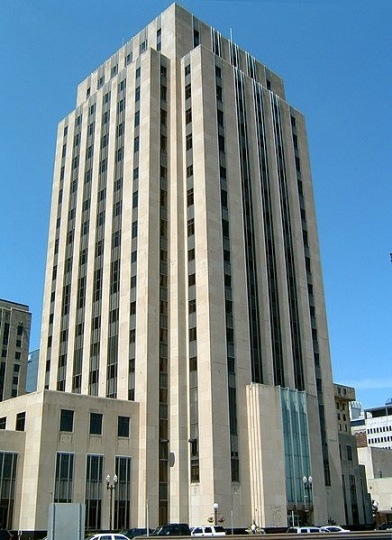
St. Paul City Hall and Ramsey County Courthouse
Public domain
More Information
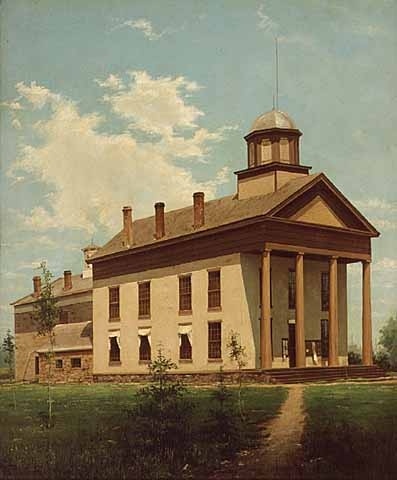
First Ramsey County Courthouse
Public domain
Holding Location
More Information
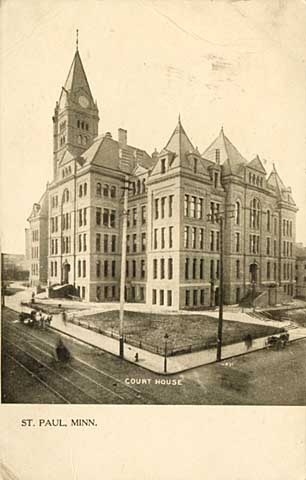
Second Ramsey County Courthouse
Public domain
Holding Location
More Information
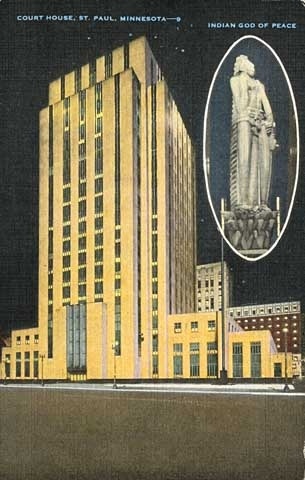
Third Ramsey County Courthouse
All rights reserved
Holding Location
More Information
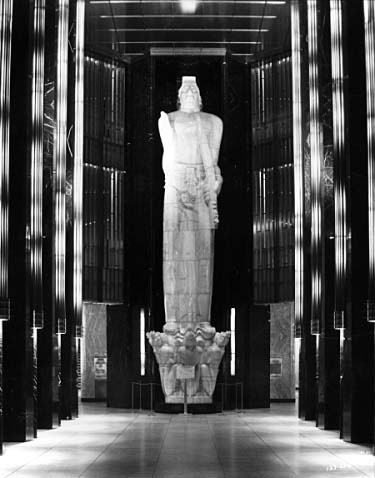
Carl Milles's God of Peace
Holding Location
More Information
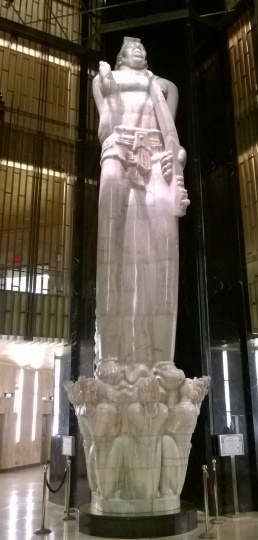
Carl Milles's Vision of Peace
All rights reserved
Holding Location
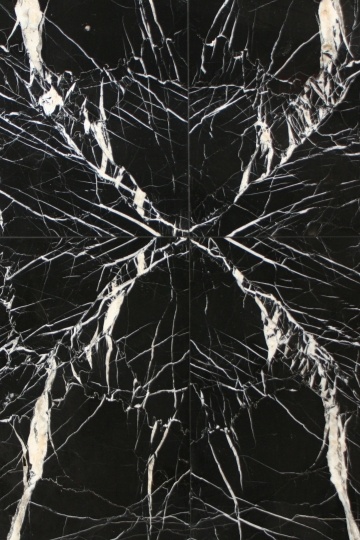
St. Paul City Hall and Ramsey County Courthouse marble
All rights reserved
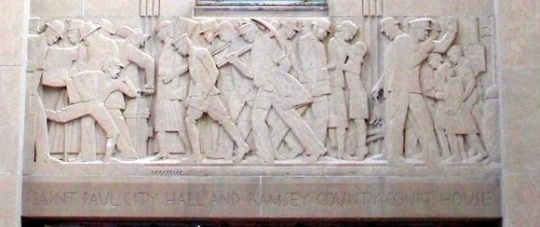
Lee Lawrie's "Voice of the People" sculpture panel
One of the panels of Lee Lawrie's "Voice of the People" relief sculpture over the north entrance of the St. Paul City Hall and Ramsey County Courthouse. Photographed by Paul Nelson on June 1, 2008.
All rights reserved
Holding Location
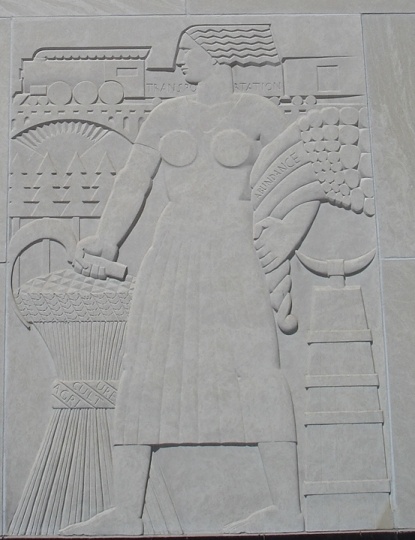
Lee Lawrie's "Voice of the People" sculpture panel
One of the panels of Lee Lawrie's "Voice of the People" relief sculpture flanking the south entrance doors of the St. Paul City Hall and Ramsey County Courthouse. Photographed by Paul Nelson on April 13, 2008.
All rights reserved
Holding Location
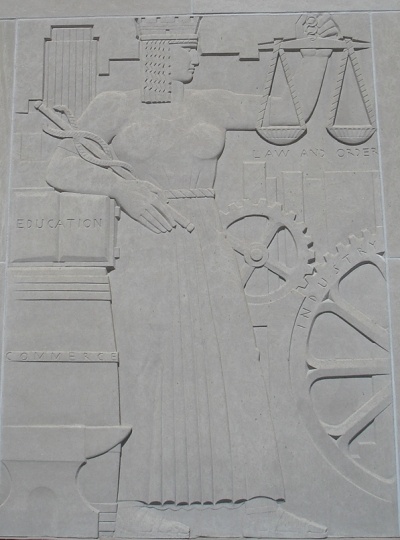
Lee Lawrie's "Voice of the People" sculpture panel
One of the panels of Lee Lawrie's "Voice of the People" relief sculpture flanking the south entrance doors of the St. Paul City Hall and Ramsey County Courthouse. Photographed by Paul Nelson on April 13, 2008.
All rights reserved
Holding Location
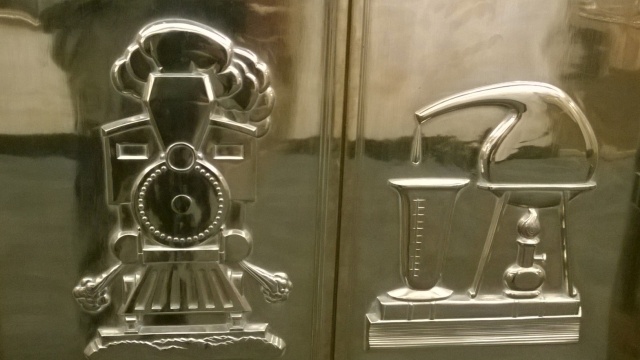
St. Paul City Hall and Ramsey County Courthouse elevator doors
All rights reserved
Holding Location
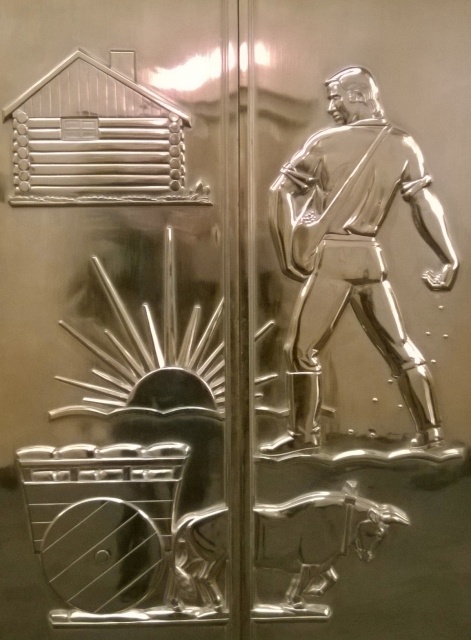
St. Paul City Hall and Ramsey County Courthouse elevator doors
All rights reserved
Holding Location
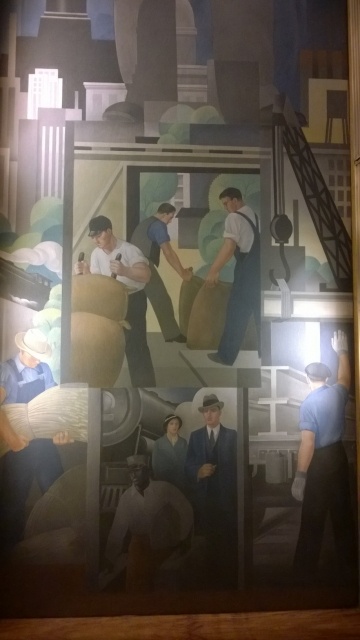
St. Paul City Hall and Ramsey County Courthouse mural panel
All rights reserved
Holding Location
Related Articles
Turning Point
The stock market crash of October 1929 and ensuing Depression lower the costs of building the courthouse. City and county officials use the money saved to spend more on ornamental stone and wood to make the building more beautiful.
Chronology
1851
1857
1885
1889
1925
1927
1929
1930
1932
1985
1988
1993
Bibliography
Kain, Sister Joan, and Paul D. Nelson. Rocky Roots: Geology and Stone Construction in Downtown St. Paul. St. Paul: Ramsey County Historical Society, 2008.
Kelley, Thomas J. "The Newly Restored, Newly Renovated City Hall and County Courthouse: A Case History of Government in Action." Ramsey County History 28, no. 3 (Fall 1993): 4–18.
Millett, Larry. AIA Guide to the Twin Cities. St. Paul: Minnesota Historical Society, 2007.
Minnesota State Census of Population, 1880, Ramsey County, Minnesota.
Minnesota State Census of Population, 1890, Ramsey County, Minnesota.
Minnesota State Census of Population, 1920, Ramsey County, Minnesota.
Nelson, Paul. "Courthouse Sculptor Lee Lawrie." Ramsey County History 43, no. 4 (Winter 2009): 3–10.
Smith, Dane. "Creation in Stone: Carl Milles's 'Finest': The God of Peace." Ramsey County History 28, no. 3 (Fall 1993): 22–24.
——— . "The City Hall-County Courthouse and Its First Fifty Years." Ramsey County History 17, no. 1 (1981): 3–16.
——— . "God of Peace: Milles' 'Finest Creation in Stone.'" Ramsey County History 17, no. 1 (1981): 17–22.
——— . "A Short and Happy History of Ramsey County and Its Two Earlier Courthouses." Ramsey County History 28, no. 3 (Fall 1993): 19–22.
Related Resources
Primary
Advisory Court House and City Hall Building Commission Records, 1929–1939
Joint Couth House and City Hall Committee
State Archives Collection, Minnesota Historical Society, St. Paul
Description: Records kept by the commission appointed to oversee the construction of the joint city hall and courthouse building.
Opening of the New Court House at Saint Paul, Minnesota, May 6, 1889. [N.p, 1889?].
Pamphlets Relating to Saint Paul City Hall and Ramsey County Court House in Minnesota, 1885–
Pamphlet Collection, Minnesota Historical Society, St. Paul
Description: Pamphlets and printed ephemera relating to the second and third court house buildings.
Saint Paul City Hall & Ramsey County Court House Grand Re-Opening. [N.p.], 1993.
Van Duyne-Moran Fixtures and Lumber Company. List of American and Imported Woods Used In Treatment of New City Hall and Court House, Saint Paul, Minnesota. [St. Paul: N.p., 1932?].
Secondary
Breeze, Carla. American Art Deco: Modernistic Architecture and Regionalism. New York: W. W. Norton and Co., 2003.
Duncan, Alastair. American Art Deco. New York: Abrams, 1986.
The Evolution of the God of Peace. [St. Paul: N.p. 1984?].
Kain, Sister Joan. Rocky Roots: Three Geology Walking Tours of Downtown St. Paul. St. Paul: Ramsey County Historical Society, 1978.
Ramsey County. Welcome to the Ramsey County Court House / St. Paul. [St. Paul, N.p.].
Saint Paul City Hall and Ramsey County Courthouse. Reprint. [St. Paul: N.p., 1933?].
Web
Minnesota Historical Society, Placeography. Saint Paul City Hall-Ramsey County Courthouse.
http://www.placeography.org/index.php/Saint_Paul_City_Hall_-_Ramsey_County_Courthouse,_15_Kellogg_Boulevard_West,_Saint_Paul,_Minnesota














